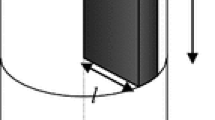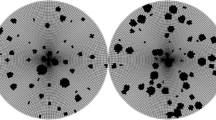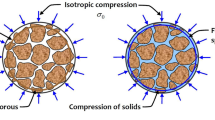Abstract
Non-homogeneity of the pore pressure field in a specimen is an issue for characterization of the thermo-poromechanical behaviour of low-permeability geomaterials, as in the case of the Callovo-Oxfordian claystone (k < 10−20 m2), a possible host rock for deep radioactive waste disposal in France. In tests with drained boundary conditions, excess pore pressure can result in significant errors in the measurement of material parameters. Analytical solutions are presented for the change in time of the pore pressure field in a specimen submitted to various loading paths and different rates. The pore pressure field in mechanical and thermal undrained tests is simulated with a 1D finite difference model taking into account the dead volume of the drainage system of the triaxial cell connected to the specimen. These solutions provide a simple and efficient tool for the estimation of the conditions that must hold for reliable determination of material parameters and for optimization of various test conditions to minimize the experimental duration, while keeping the measurement errors at an acceptable level.











Similar content being viewed by others
Abbreviations
- ϕ :
-
Porosity
- ϕ 0 :
-
Porosity in the reference state
- V :
-
Total volume
- V 0 :
-
Total volume in the reference state
- V ϕ :
-
Pore volume
- V ϕ0 :
-
Pore volume in the reference state
- σ :
-
Total stress
- σ d :
-
Differential stress
- p f :
-
Pore pressure
- T :
-
Temperature
- K d :
-
Drained bulk modulus
- K p :
-
Drained bulk modulus of the pore space
- K s :
-
Unjacketed modulus
- K ϕ :
-
Unjacketed modulus of the pore space
- H :
-
Biot’s modulus
- α d :
-
Drained thermal expansion coefficient
- α ϕ :
-
Drained thermal expansion coefficient of the pore space
- K u :
-
Undrained bulk modulus
- B :
-
Skempton’s coefficient
- α u :
-
Undrained thermal expansion coefficient
- Λ :
-
Thermal pressurization coefficient
- K mesu :
-
Measured undrained bulk modulus containing an error
- α mesu :
-
Measured undrained thermal expansion coefficient containing an error
- B mes :
-
Measured Skempton’s coefficient containing an error
- Λ mes :
-
Measured thermal pressurization coefficient containing an error
- ε :
-
Volumetric strain
- σ′ :
-
Biot’s effective stress
- b :
-
Biot’s coefficient
- m f :
-
Fluid mass per unit volume
- k :
-
Intrinsic permeability
- ρ :
-
Bulk density
- ρ f :
-
Fluid density
- µ f :
-
Fluid dynamic viscosity
- K f :
-
Fluid bulk modulus
- α f :
-
Fluid thermal expansion coefficient
- S :
-
Storage coefficient
- t :
-
Time
- θ :
-
Dimensionless time
- z :
-
Length coordinate
- Z :
-
Dimensionless length
- H d :
-
Drainage length
- τ v :
-
Characteristic time
- θ crit :
-
Critical dimensionless time
- t crit :
-
Critical time
- c fluid :
-
Fluid diffusion coefficient
- c heat :
-
Thermal diffusion coefficient
- λ :
-
Bulk thermal conductivity
- C :
-
Bulk specific heat
- U :
-
Degree of consolidation
- η :
-
Geometry factor for drainage condition
- p init :
-
Initial pore pressure
- p exf :
-
Excess pore pressure
- v :
-
Loading rate
- v σ :
-
Rate of confinement pressure
- v p :
-
Rate of pore pressure
- v T :
-
Rate of temperature
- i :
-
Index of loading section
- N :
-
Index of current loading section
- t i :
-
Start time of loading section i
- v σ,i :
-
Rate of confinement pressure in loading section i
- v p,i :
-
Rate of pore pressure in loading section i
- v T,i :
-
Rate of temperature in loading section i
- M R :
-
Total fluid mass in the drainage system
- A :
-
Specimen boundary surface
- V R :
-
Reservoir volume
- V R,0 :
-
Reservoir volume in the reference state
- K R :
-
Reservoir bulk modulus
- Λ R :
-
Reservoir thermal pressurization coefficient
- α R :
-
Reservoir thermal expansion coefficient
- R :
-
Reservoir factor
- S R :
-
Reservoir storage coefficient
- F 1 :
-
Function for pore pressure distribution
- F 2 :
-
Function for pore pressure time derivative
- β :
-
Measured tangent parameter
- \(\epsilon_{\beta}\) :
-
Error on the measured tangent parameter
- χ :
-
Pore pressure coefficient measured in the reservoir
- \(\epsilon_{\chi}\) :
-
Error on the measured pore pressure coefficient
References
Andra (2005) Dossier 2005 Argile: Evaluation of the feasibility of a geological repository in an argillaceous formation. http://www.andra.fr/international/download/andra-international-en/document/editions/266va.pdf
Belmokhtar M, Delage P, Ghabezloo S, Tang A-M, Menaceur H, Conil N (2017a) Poroelasticity of the Callovo–Oxfordian claystone. Rock Mech Rock Eng 50:871–889
Belmokhtar M, Delage P, Ghabezloo S, Conil N (2017b) Thermal volume changes and creep in the Callovo–Oxfordian claystone. Rock Mech Rock Eng 50:2297–2309
Berryman JG (1992) Effective stress for transport properties of inhomogeneous porous rock. J Geophys Res 97:17409
Biot MA, Willis DG (1957) The elastic coefficients of the theory of consolidation. J Appl Mech 24:594–601
Bishop AW (1976) The influence of system compressibility on the observed pore-pressure response to an undrained change in stress in saturated rock. Géotechnique 26:371–375
Carslaw HS, Jaeger JC (1959) Conduction of heat in solids, 2nd edn. Clarendon Press, Oxford
Cheng AH-D (2016) Poroelasticity, vol 27. Springer, Cham
Conil N, Gatimiri B, Armand G (2010) Premiers résultats de l’expérimentation TED. ANDRA report D.RP.AMFS.10.0067
Davy CA, Skoczylas F, Barnichon J-D, Lebon P (2007) Permeability of macro-cracked argillite under confinement: gas and water testing. Phys Chem Earth Parts A/B/C 32:667–680
Delage P, Sultan N, Cui YJ (2000) On the thermal consolidation of Boom clay. Can Geotech J 37:343–354
Escoffier S (2002) Caractérisation expérimentale du comportement hydromécanique des argilites de Meuse Haute-Marne. Institut National Polytechnique de Lorraine
Escoffier S, Homand F, Giraud A, Hoteit N, Su K (2005) Under stress permeability determination of the Meuse/Haute-Marne mudstone. Eng Geol 81:329–340
Garitte B, Gens A, Vaunat J, Armand G (2014) Thermal conductivity of argillaceous rocks: determination methodology using in situ heating tests. Rock Mech Rock Eng 47:111–129
Geertsma J (1957) A remark on the analogy between thermoelasticity and the elasticity of saturated porous media. J Mech Phys Solids 6:13–16
Ghabezloo S, Sulem J (2009) Stress dependent thermal pressurization of a fluid-saturated rock. Rock Mech Rock Eng 42:1–24
Ghabezloo S, Sulem J (2010) Effect of the volume of the drainage system on the measurement of undrained thermo-poro-elastic parameters. Int J Rock Mech Min Sci 47:60–68
Ghabezloo S, Sulem J, Saint-Marc J (2009a) The effect of undrained heating on a fluid-saturated hardened cement paste. Cem Concr Res 39:54–64
Ghabezloo S, Sulem J, Saint-Marc J (2009b) Evaluation of a permeability-porosity relationship in a low-permeability creeping material using a single transient test. Int J Rock Mech Min Sci 46:761–768
Gibson RE, Henkel DJ (1954) Influence of duration of tests at constant rate of strain on measured “drained” strength. Géotechnique 4:6–15
Guayacán-Carrillo L-M, Ghabezloo S, Sulem J, Seyedi DM, Armand G (2017) Effect of anisotropy and hydro-mechanical couplings on pore pressure evolution during tunnel excavation in low-permeability ground. Int J Rock Mech Min Sci 97:1–14
Guenther RB, Lee JW (1996) Partial differential equations of mathematical physics and integral equations. Dover, New York
Hancock M (2006) The 1-D heat equation. In: MIT Course 18.303 Linear Partial Differential Equations. https://ocw.mit.edu/courses/mathematics/18-303-linear-partial-differential-equations-fall-2006/lecture-notes/heateqni.pdf
Homand F, Giraud A, Escoffier S et al (2004) Permeability determination of a deep argillite in saturated and partially saturated conditions. Int J Heat Mass Transf 47:3517–3531
Hu DW, Zhang F, Shao JF (2014) Experimental study of poromechanical behavior of saturated claystone under triaxial compression. Acta Geotech 9:207–214
Makhnenko RY, Tarokh A, Podladchikov YY (2017) On the unjacketed moduli of sedimentary rock. In: Poromechanics VI. pp 897–904
Menaceur H, Delage P, Tang A, Conil N (2015) The thermo-mechanical behaviour of the Callovo–Oxfordian claystone. Int J Rock Mech Min Sci 78:290–303
Mohajerani M, Delage P, Monfared M, Tang A-M, Sulem J, Gatmiri B (2011) Oedometric compression and swelling behaviour of the Callovo–Oxfordian argillite. Int J Rock Mech Min Sci 48:606–615
Mohajerani M, Delage P, Sulem J, Monfared M, Tang A-M, Gatmiri B (2012) A laboratory investigation of thermally induced pore pressures in the Callovo–Oxfordian claystone. Int J Rock Mech Min Sci 52:112–121
Mohajerani M, Delage P, Sulem J, Monfared M, Tang A-M, Gatmiri B (2014) The thermal volume changes of the Callovo–Oxfordian claystone. Rock Mech Rock Eng 47:131–142
Monfared M, Delage P, Sulem J, Mohajerani M, Tang A-M, De Laure E (2011) A new hollow cylinder triaxial cell to study the behavior of geo-materials with low permeability. Int J Rock Mech Min Sci 48:637–649
Myint-U T, Debnath L (2007) Linear partial differential equations for scientists and engineers. Birkhäuser, Boston
Skempton AW (1954) The pore-pressure coefficients A and B. Géotechnique 4:143–147
Spang B (2002) Excel add-in for properties of water and steam in SIunits. http://www.cheresources.com/iapwsif97.shtml
Wissa AEZ (1969) Pore pressure measurement in saturated stiff soils. J Soil Mech Found Div 95:1063–1073
Zhang CL (2011) Experimental evidence for self-sealing of fractures in claystone. Phys Chem Earth 36:1972–1980
Zimmerman W, Somerton WH, King MS (1986) Compressibility of porous rocks. J Geophys Res 91:12765–12777
Author information
Authors and Affiliations
Corresponding author
Appendix: Calculation of Time-Dependent Pore Pressure Distribution
Appendix: Calculation of Time-Dependent Pore Pressure Distribution
Assuming a fluid flow governed by Darcy’s law, the pressure change in porous media can be described through Eq. (16). The pressure change is therefore dependent on the pressure gradient and a volumetric pressure source q:
Considering a domain of the length 2Hd, the pore pressure diffusion problem can hence be described as a function of dimensionless time θ and dimensionless length Z:
The pore pressure is initially equal to zero over the specimen length, whereas it is controlled at the specimen ends is using a certain pore pressure loading rate vp.
In the following, this problem is solved in the same way as it was described in detail for heat diffusion with sources in Hancock (2006), Guenther and Lee (1996) and Myint-U and Debnath (2007). We have to find an equilibrium solution uE(Z) that satisfies the PDE and the BCs:
We define u(Z,θ) as:
Substituting uE(Z,θ) from the above relation, we obtain:
To solve a diffusion equation with time-dependent boundary conditions, such as u(Z,θ), Carslaw and Jaeger (1959, pp. 103) propose the following analytical solution for uC over the length 0 < x < L, the time t (with \(\frac{{{\text{d}}u_{\text{C}} }}{{{\text{d}}t}} = \kappa \frac{{\partial^{2} u_{\text{C}} }}{{\partial x^{2} }}\), where κ is the diffusion coefficient, ϕ1(t) and ϕ2(t) are the boundary conditions for uc(0, t) and uc(L, t), respectively, and f(x) is the initial distribution of uc(x, 0)):
To obtain the solution for u(Z, θ), we insert L = 2, κ = 1 into Eq. (68) and replace t with θ and x with Z. For the boundary conditions, we can insert \(\phi_{1} \left( \lambda \right) = \phi_{2} \left( \lambda \right) = v_{p} \tau_{v} \lambda\) and \(f(x^{{\prime }} ) = - u_{E} (x^{{\prime }} )\).
The first integral in Eq. (69) can be solved by partial integration:
The first term in the right-hand side of Eq. (70) disappears because of the boundary conditions uE(0) = uE(2) = 0. Partial integration applied on the remaining second term gives:
Here the first term of Eq. (71) vanishes, as sin(nπ) = 0. From Eq. (62), we can insert \({{\partial^{2} u_{E} (x')} \mathord{\left/ {\vphantom {{\partial^{2} u_{E} (x')} {\partial x'^{2} }}} \right. \kern-0pt} {\partial x'^{2} }} = - q\) to obtain:
It can be seen that Eq. (72) becomes nonzero only for odd values of n. Note also that the second integral in Eq. (69) is nonzero only for odd values of n. For this reason, the variable n is replaced by (2n − 1) and we introduce:
Equation (69) can then be rewritten to:
The remaining integral in Eq. (74) can be solved by partial integration. We also make use of the relationship \(\sum\nolimits_{n = 1}^{\infty } {\frac{1}{m}} \sin \left( {mZ} \right) = \frac{1}{2}\), giving:
From the initial condition at θ = 0, we know that:
This allows us to write down the final analytical solution for pf, using Eqs. (64), (75) and (76):
Rights and permissions
About this article
Cite this article
Braun, P., Ghabezloo, S., Delage, P. et al. Theoretical Analysis of Pore Pressure Diffusion in Some Basic Rock Mechanics Experiments. Rock Mech Rock Eng 51, 1361–1378 (2018). https://doi.org/10.1007/s00603-018-1410-8
Received:
Accepted:
Published:
Issue Date:
DOI: https://doi.org/10.1007/s00603-018-1410-8




